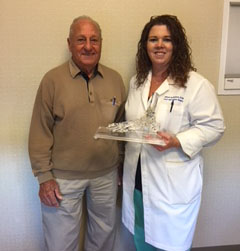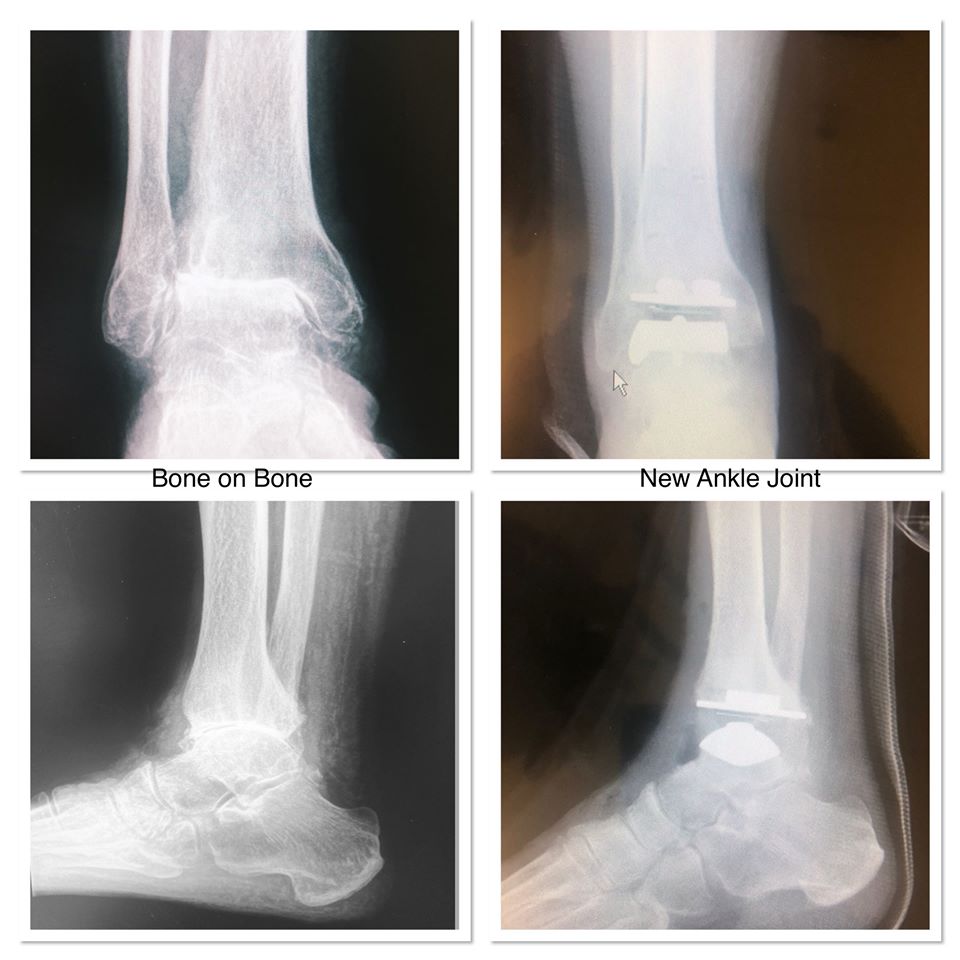
Dr. Alison DeWaters holds a model of an ankle replacement prosthesis while standing with Herbert Hock, whose ankle she replaced in April 2019.
Treating Ankle Pain with STAR Ankle Replacement
Patient is pain free after ankle replacement
Before he had ankle replacement surgery in April 2019, 90-year old Herbert H. experienced debilitating pain from the bone-on-bone arthritis in his ankle. Forced by the pain to limp and give up his favorite activities including skiing and riding his motorcycle, he says he had “no quality of life.”
Thanks to STAR Ankle replacement surgery performed by foot and ankle surgeon Dr. Alison DeWaters, Herbert is active again, and even looking forward to getting back on his motorcycle. Dr. DeWaters is a board-certified podiatric surgeon at Advanced Orthopedics and Sports Medicine. She received her degree in Podiatric Medicine from Temple and completed a four-year residency in podiatric reconstructive foot and ankle surgery at the University of Pennsylvania.
“The STAR implant is a great alternative to an ankle fusion with increased mobility and a decreased risk of surrounding joint arthritis after,” Dr. DeWaters says.
At his six month checkup in October, Herbert was walking and no longer in pain. “I couldn’t be happier,” he says. “Dr. DeWaters is the best.”

Prior to ankle replacement surgery, Herbert Hock’s ankle joint was bone-on-bone, which caused debilitating pain.
What is total ankle replacement surgery?
Total ankle replacement is a surgical procedure that replaces the damaged bone and cartilage in the ankle joint with an artificial implant. It is performed to treat painful conditions of the ankle, such as arthritis. It is designed to relieve pain while still allowing you to move your ankle. When conservative treatments such as pain medications no longer help alleviate pain, your doctor may recommend ankle replacement.
What is the STAR Ankle System?
The ankle joint (tibiotalar joint) is the area where the bottom of the shin bone (tibia) rests on top of a bone in the foot called the talus bone. The shin bone is the long bone that runs from the bottom of your knee to the top of your ankle.
STAR stands for Scandinavian Total Ankle Replacement, designed by a well-known surgeon in Scandanavia. The STAR Ankle is made up of three parts. The first part covers the talus bone. The second part covers the very bottom of your shin bone. Both of these parts are made of a combination of metals called cobalt chromium alloy. These parts are covered with another metal, pure titanium, in the places where they actually touch your bone.
The third part of the STAR Ankle is called a Mobile Bearing and is placed in between the two metal parts. The Mobile Bearing is made out of medical grade plastic called polyethylene and is designed to move in between the metal parts as you move your ankle.
“Patients walking is significantly improved after the implant over a fusion,” Dr. DeWaters says.
The STAR Ankle procedure requires the surgeon to make a cut along the front of the ankle to open the ankle joint. A small portion of bone is then removed from the ankle joint to make space for the metal and medical grade plastic parts. Unlike other ankle replacement systems, the STAR Ankle does not require the use of bone cement. Unlike ankle fusion, the STAR Ankle allows more mobility.
What are the similarities and differences between the STAR Ankle and other ankle replacements?
With all ankle replacement surgeries, metal components replace the bone surfaces of the ankle. As mentioned previously, with STAR Ankle replacement, the two metal parts are separated by the Mobile Bearing, which is designed to mimic the natural motion of the ankle as you do daily activities like walking. All other ankle implants in the U.S. have the plastic attached to one of the metal parts.
The STAR Ankle is the only ankle replacement used in the United States that attaches directly to your bone without the need for bone cement. Ankle implants, other than the START Ankle, require the use of bone cement to attach the implants to the bone.
Recovery after STAR Ankle Replacement
Most patients are in the hospital for two or three days. Some patients have shorter stays, while others may stay in the hospital for longer than five days. Typically, prior to putting any weight on your ankle, you may use crutches or a walker for a minimum of two weeks after surgery. Your doctor will let you know when you may begin putting some of your weight on your ankle. You will be required to see a physical therapist, who will teach you exercises that will help you move more easily. You most likely won’t be able to put any weight on the ankle for a few months. You will have to wear a fitted booth for several months.
What activities can you do after recovering from ankle surgery?
After an ankle replacement, you may be able to do as much walking and swimming as you like. You may also participate in non-impact activities, such as golf. You should not run, jump, perform heavy lifting or manual labor unless your surgeon allows it. These types of activities may cause the ankle replacement to loosen or break. This may require further therapy, or even surgery. Ask your surgeon about other activities you’re interested in to find out if they’re okay for you to do. Keeping your weight down and not smoking are things that may help increase the life of an ankle replacement.
Risks with Ankle Replacement
As with any surgery, there are potential risks with ankle replacement. Some risks include misalignment of the bones, loosening of the artificial components over time and wearing out of the components.
Results of Ankle Replacement
Ankle replacement will help you decrease or get rid of your ankle pain. It will increase your ankle’s mobility and allow you to move your ankle up and down. Depending on your health, activity level and amount of damage to your ankle joint before surgery, an ankle replacement can last 10 years or more in most cases.








